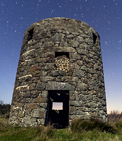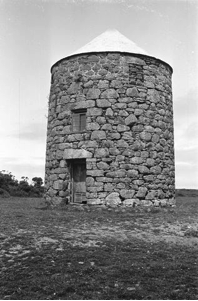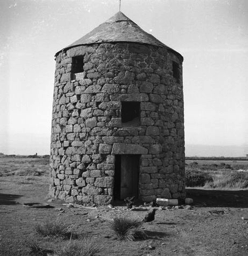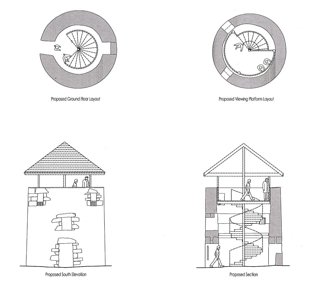![]()
Archaeological interest Most of the nature reserve (80%) lies within an Area of Great Historic Value (AGHV) and the windmill tower itself is a Scheduled Ancient Monument and Grade II Listed Building. It is one of only five surviving windmill towers in Cornwall. A Bronze Age barrow close to the windmill is one of a number of other features of the site which the Cornwall Archaeological Unit (CAU) considers to be of national importance and worthy of assessment for Scheduling.
Most of the nature reserve (80%) lies within an Area of Great Historic Value (AGHV) and the windmill tower itself is a Scheduled Ancient Monument and Grade II Listed Building. It is one of only five surviving windmill towers in Cornwall. A Bronze Age barrow close to the windmill is one of a number of other features of the site which the Cornwall Archaeological Unit (CAU) considers to be of national importance and worthy of assessment for Scheduling.
The CAU carried out an Archaeological Assessment in 2002 and recommended that the best way of ensuring the windmill’s preservation would be through continuing use. The CAU report advised that works to repair and consolidate the structure would inevitably be part of that strategy (for health and safety reasons, if nothing else), and that the preferred historical option would be to re-roof the structure and provide a viewing area at the top. It was suggested that a free-standing structure could be built inside the tower to provide the necessary steps and walkway. Interpretation panels were also suggested.
History –1600 to WWII
The windmill is thought to have been built in about 1600. One of the most prominent landmarks on the Lizard peninsula, it was already being referred to as “an old mill” by the time of the Lanhydrock Atlas of 1695. In Joel Gascoyne’s 1699 map of Cornwall it is labelled as “Old Windmill” and depicted as a tower with a conical cap but with no sails.
Records show that throughout its history the windmill has been through alternating periods of use and disuse, marked by restoration and subsequent deterioration of the building. The last county map showing the windmill in working order was produced in 1827, and it is believed that it carried on working until the 1840s.
Because of its importance as a reference point for seafarers, it was necessary that the windmill should be prevented from collapsing. Records from 1916 and 1930 indicate that the building had a modern roof, after many roofless years, and had been used as a store.
The historian Charles Henderson described it in 1935 as “The finest and most romantic of all Cornish windmills”. A particularly interesting episode in the windmill’s history concerns the activities of the notorious ‘Windmill Gang’ of sheep-stealers and footpads (highwaymen on foot) in and around the 1820s. Given that the tip of the Lizard peninsula was further away from urban life and civil authority than any other part of mainland Cornwall, it is not surprising that this area was the scene of much lawlessness. At a trial in 1829 a butcher named Alexander Hocking admitted to having been employed by the gang to kill and cut up sheep at the windmill. From there, the meat and wool were to be taken to caves (still known as Sheep Stealers‟ Caves), on the coast near Kynance, and shipped to Falmouth.
One of the fields near the windmill, called ‘Oliver Tucker’s Grave’, is said to be the place where the gang murdered and buried a man of that name who had given evidence against them. (To this day local people say the windmill is haunted).
History –WWII and beyond
Much more recently, the windmill was used as a Home Guard observation post in World War II and three pillboxes were set out in a defensive triangle within 50 yards of it. There are also remains of several other buildings on the farm that were constructed as part of the Predannack Downs airfield complex. Early in WWII, building work began for an RAF advanced night fighter base to protect the nearby ports of Falmouth and Penzance. RAF Predannack Downs opened in 1941 as part of Portreath Sector. Coastal Command squadrons flew anti-submarine sorties from the airfield into the Bay of Biscay, as well as convoy support in the western English Channel, using aircraft such as Beaufighters and De Havilland Mosquitoes.
In the early 1950s Predannack was secretly used by the famous aeronautical engineer Barnes Wallis in the development of his futuristic, supersonic, swing-wing Swallow and Goose aircraft projects. The airfield was taken over by the Royal Navy in 1958 and is now used as a training base for helicopters, gliders and fire-fighting.
The windmill’s protective roof was lost in about 1965 and in the winter of 1969 gales damaged the roofless tower. In 1971 the top was pointed, in an attempt to prevent further deterioration.
| Photographs by D W Muggeridge (University of Kent collection). | |
 |
 |
| 1938 | 1953 |
The windmill tower has been deteriorating during the last 15 years and the Trust and Society have tried various ‘patch-up’ jobs to stop further decline. In 2013, Natural England funded professional surveys of the windmill and this lead to some immediate work that was of pressing concern. These surveys and costings helped to put together the current Lizard Horizons Project. As preparation for this project, PWH Associates Ltd has successfully applied for Planning Permission and Scheduled Monument consent to allow the works to the windmill to go ahead. The new plans (an early draft is shown below) built upon the recommendation from the 2002 CAU report to incorporate a viewing platform.

The windmill tower is a Scheduled Monument and as such the staircase, platform and roof have had to been designed and engineered to be free standing. When complete, this new feature should not only offer fantastic view of the Lizard peninsula but provide the protection that the windmill tower needs.

